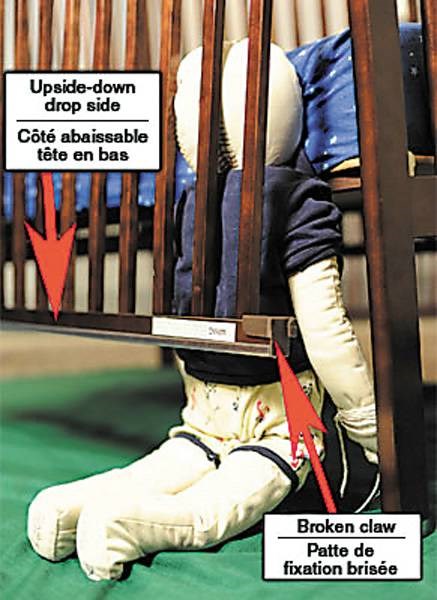A popular line of baby cribs with a unique drop-side that has been in the marketplace since 1993 is being recalled due to a potentially hazardous flaw.
The joint recall by Stork Craft, Health Canada and the United States Consumer Product Safety Commission encompasses all Stork Craft drop-side cribs with manufacture and distribution dates between January 1993 and October 2009, as well as Stork Craft drop-side cribs with the Fisher-Price logo with manufacture dates between October 1997 and December 2004.
The manufacture date, model number and crib name are printed on the assembly instructions attached to the mattress support board.
The plastic hardware for the crib’s drop-side can break or deform. It has also been found that the drop-side can be installed upside-down, which can cause plastic parts to break or disengage. When the drop-side detaches, it creates a space between the drop-side and the crib mattress in which infants and toddlers can become trapped, potentially leading to suffocation.
While the crib meets current safety standards, a number of reported incidents have demonstrated the hardware can break. In Canada, there have been three reports of entrapment, eight reports of falls from the crib and 32 other reported incidents related to broken plastic hardware. Officials in the United States have received reports of 12 entrapments, four incidents of suffocation, 12 falls and 43 other incidents.
Consumers should immediately inspect their crib and examine the plastic drop-side hardware for any signs of damage or to see if it was installed upside down. Parents should stop using the crib immediately if they see anything that causes them concern and arrange for safe sleeping arrangements for their child. Instead of returning the crib, consumers can contact Stork Craft at 1-877-274-0277 to obtain a free repair kit that converts the drop-side to a fixed side or for free replacement parts.
In Canada, some 968,841 of the recalled cribs have been distributed across Canada, sold at Sears Canada, Wal-Mart Canada and other specialty retailers. Another 1.2 million cribs were distributed in the United States.
A study published in the journal Pediatrics has found early intervention in children diagnosed with autism as young as 18 months can drastically improve IQ, social interaction and language.
Based out of the University of Washington in Seattle, the five-year study incorporated the Early Start Denver Model (ESDM), based on developmental relationships between parent and child and teacher and child. According to the study, the model “blends the discipline of behaviour analysis with play-based routines as a way to build a relationship with the child with autism.”
The research team recruited 48 children with autism aged 18 to 30 months old and split them into two groups — one group spent 20 hours a week in (ESDM) sessions with specialists and parents, while the second group received therapy in community-based programs. There were no differences between the children when the study began.
At the conclusion, the research team found that the children in the ESDM group showed significant improvements in autism diagnosis, adaptive behaviour and IQ. More specifically, the ESDM group showed an 18-point improvement in IQ over an average four-point improvement in the community group, an 18-point improvement in receptive language compared to 10 for the community group. In total, seven children improved to the extent their diagnosis was changed from autism to the “more mild” pervasive developmental disorder. Only one child in the community group had a change in diagnosis.
The research team stated the findings show “the importance of early detection of and intervention in autism.”
Middle-aged men and women who perform lots of high-impact exercises such as running and jumping might be putting themselves at greater risk of developing osteoarthritis compared to those who swim or cycle instead.
The study, presented Monday at the 95th Scientific Assembly and Annual Meeting of the Radiological Society of North America, analyzed data in 100 men and 136 women aged 45 to 55. None of the participants reported knee pain when the study began and all had a healthy weight. The participants then self-assessed their level of physical activity, which the researchers used to categorize them.
Two researchers analyzed MRI images of the participants to look for existing damage in the right knee. Of the participants, 47 per cent had meniscal lesions, 74.6 had cartilage lesions, 40.3 per cent had bone marrow edema and 17 per cent had ligament lesions. The incidences of cartilage lesions, knee abnormalities and other abnormalities increased as the participants’ level of physical activity increased to the point that the most active participants showed the most damage. The abnormalities were all linked with activity levels only and had nothing to do with age or gender.
The researchers also noted, “Cartilage defects in diagnosed in active people were more severe.”
The team said low-impact activities such as swimming and cycling might protect diseased cartilage and prevent disease, such as osteoarthritis.




